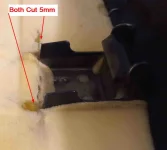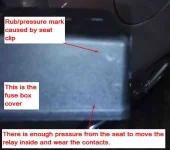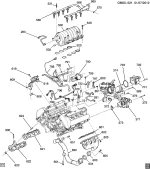You are using an out of date browser. It may not display this or other websites correctly.
You should upgrade or use an alternative browser.
You should upgrade or use an alternative browser.
Fuel pump relay
- Thread author Rigo1G
- Start date
DrivenDaily
Well-known member
- Joined
- Feb 20, 2024
- Messages
- 884
- Reaction score
- 491
- Points
- 63
- Buick Ownership
- 2005 LeSabre Limited
Too much current being drawn by the pump or some other issue.
2007LucerneCXL
Full Member
- Joined
- Jun 19, 2015
- Messages
- 12,862
- Reaction score
- 4,806
- Points
- 113
- Location
- Illinois
- Buick Ownership
- 2007 Lucerne CXL. and 1995 Lesabre currently, past 1973 Riviera, 1968 Riviera
2008 and up Buick Lucerne's have a problem with the rear seat fuse box with the fuel pump relay. Replacement of the fusebox or modified the the relay location as a possible repair which is dependent on how much damage is done to the box.
Lots of posts on the site in the Lucerne forum.

 buickforums.com
buickforums.com
Lots of posts on the site in the Lucerne forum.

2008 Buick Lucerne Fuel Pump Relay Issue
hi all, i purchased my 2008 buick lucerne two summers ago with a little under 60k miles on it, its currently at 78k. haven’t had many issues with it at all until recently, first time was when my car wouldn’t start as the battery wasn’t getting enough power, so the alternator was replaced. a few...
Movedon
New member
- Joined
- Sep 6, 2024
- Messages
- 18
- Reaction score
- 2
- Points
- 3
- Buick Ownership
- Lucerne
Hi,
First post here, interesting to see this issue.
I had the same problem.
There was a technical service bulletin about this for Lucerne and Cadillac DTS.
The problem/cause is probably the back seat. Not to say it couldn't be a pump going bad, or a bad ground, but this is the one that I had after all the research.
There is a metal tab (usually one causes it but there are two) under the seat that's part of the seat frame that has to be cut off, described in GM Technical Bulletin SB-10108617-9340. There are photos in the bulletin indicating how to do the fix. (Attached mine also)
GM put a relay in that had a higher (tall) profile, which meant the cover rubbed on it.
You can get an idea very easily just by lifting the back seat lower cushion and look to see if those tabs are there. If so, that's likely the cause of the problem.
What happens is that this tab presses against the fuse block cover right by the fuel pump relay - which wiggles the fuel pump relay causing the contacts to loosen and short over time - resulting in burning out the relay.
The good news is that this is probably the fix if the tabs were not cut off by a dealer when the bulletin was released. There was actually a secret warranty up until about 2020.
The bad news is that the contacts inside the block (the female part) get hot and expand and oxidize meaning you get poor contact, then even putting in a new relay will result in it moving around with the heat from resistance and being loose, shorting, and popping the relay again.
In mine the final fix was to modify the seat, and replace the fuse block. I did that about a year ago and have had no further problems at all with it.
I did try messing around trying to clean the contacts inside as well as I could and shim the contacts with small brass strips but no use.
There was one video I found where the person went to great lengths to disassemble the fuse block and replace the contacts inside (double ended females in a two-part block assembly).
I can't guess whether that worked for him long-term, but I decided to just replace it since the block itself scorched with two repeated burnups of the relays.
I'm attaching a photo of the block and the current GM OEM part number. There are still some around, pricy but worth it.
I tried attaching the bulletin pdf, but the forum won't allow a 4mb upload.
Here is a link to the bulletin on the NHTSA website
It covers 2008 - 2011 Lucerne and Cadillac DTS
I'd shop around for prices but here is on source:
 www.gmpartsgiant.com
www.gmpartsgiant.com
It took about 45 minutes to Re & Re - I did it myself.
It was straight forward.
Do the seat modification if it hasn't been done and there is no other cause to burn out relays (bad pump etc.)
1. Disconnect battery
2. Disconnect fuse block battery cable
3. Remove old block
4. Compare old block and new block and remove un-needed/unused fuses and relays from the new one (the new one is fully loaded so you don't have to transfer old/used ones into a new block)
5. Be sure to clean the contact surface of the power/battery cable to the block.
6. For good measure I removed the ground/negative cable where it bolts to the body and cleaned both to make sure I had good ground.
7. Clean both battery posts/pads, and terminals.
8. Install the new block.
9. Put it back together, connect the battery (+Positive cable first, then -Negative ground) and you should be good to go.
If that's not it - good luck finding the cause.
First post here, interesting to see this issue.
I had the same problem.
There was a technical service bulletin about this for Lucerne and Cadillac DTS.
The problem/cause is probably the back seat. Not to say it couldn't be a pump going bad, or a bad ground, but this is the one that I had after all the research.
There is a metal tab (usually one causes it but there are two) under the seat that's part of the seat frame that has to be cut off, described in GM Technical Bulletin SB-10108617-9340. There are photos in the bulletin indicating how to do the fix. (Attached mine also)
GM put a relay in that had a higher (tall) profile, which meant the cover rubbed on it.
You can get an idea very easily just by lifting the back seat lower cushion and look to see if those tabs are there. If so, that's likely the cause of the problem.
What happens is that this tab presses against the fuse block cover right by the fuel pump relay - which wiggles the fuel pump relay causing the contacts to loosen and short over time - resulting in burning out the relay.
The good news is that this is probably the fix if the tabs were not cut off by a dealer when the bulletin was released. There was actually a secret warranty up until about 2020.
The bad news is that the contacts inside the block (the female part) get hot and expand and oxidize meaning you get poor contact, then even putting in a new relay will result in it moving around with the heat from resistance and being loose, shorting, and popping the relay again.
In mine the final fix was to modify the seat, and replace the fuse block. I did that about a year ago and have had no further problems at all with it.
I did try messing around trying to clean the contacts inside as well as I could and shim the contacts with small brass strips but no use.
There was one video I found where the person went to great lengths to disassemble the fuse block and replace the contacts inside (double ended females in a two-part block assembly).
I can't guess whether that worked for him long-term, but I decided to just replace it since the block itself scorched with two repeated burnups of the relays.
I'm attaching a photo of the block and the current GM OEM part number. There are still some around, pricy but worth it.
I tried attaching the bulletin pdf, but the forum won't allow a 4mb upload.
Here is a link to the bulletin on the NHTSA website
It covers 2008 - 2011 Lucerne and Cadillac DTS
I'd shop around for prices but here is on source:
84446208 - GM Parts Giant
It took about 45 minutes to Re & Re - I did it myself.
It was straight forward.
Do the seat modification if it hasn't been done and there is no other cause to burn out relays (bad pump etc.)
1. Disconnect battery
2. Disconnect fuse block battery cable
3. Remove old block
4. Compare old block and new block and remove un-needed/unused fuses and relays from the new one (the new one is fully loaded so you don't have to transfer old/used ones into a new block)
5. Be sure to clean the contact surface of the power/battery cable to the block.
6. For good measure I removed the ground/negative cable where it bolts to the body and cleaned both to make sure I had good ground.
7. Clean both battery posts/pads, and terminals.
8. Install the new block.
9. Put it back together, connect the battery (+Positive cable first, then -Negative ground) and you should be good to go.
If that's not it - good luck finding the cause.
Attachments
Last edited:
JLF_1977
New member
- Joined
- Apr 22, 2025
- Messages
- 9
- Reaction score
- 2
- Points
- 3
- Buick Ownership
- 2011 Lucerne
I had this problem with mine. There is a revised fuse box that I swapped in...but my original problem took out the fuel pump, too. I did not cut the tabs on mine...the back seat is never used.
bchallus
New member
- Joined
- Nov 16, 2025
- Messages
- 3
- Reaction score
- 0
- Points
- 1
- Buick Ownership
- 2009 Buick Lucerne Super
I had the same exact problem and Movedon is 100% right. It's the bracket on the back seat which applies pressure on the fuse box, in turn applying pressure on the fuel pump fuse burning them out. You have to cut a piece of the seat bracket off and be weary of having too much weight in that back driver side seat. I burnt 3 fuses in about 3 weeks, and it also almost fried the entire fuse box. I took the fuse box out, and opened it up (which was very difficult to do). There are these little metal clips that hold the prongs to each fuse, that was toast and corroded from the repeated frying of fuses, so I took one out of the good looking clips out of a cigarette lighter that I never used, and put that on the fuel pump fuse spot that was faulty. Those little tiny metal clips were impossible to get so I had to makeshift it. Never happened again..
Although now the car at 79k is blowing smoke out of the tailpipe and i'm worried I have a blown head gasket with misfire cylinder 3 and service stabilitrak codes... Long story short, this car is very poorly designed and I would sell it ASAP before some BS happens to you
Although now the car at 79k is blowing smoke out of the tailpipe and i'm worried I have a blown head gasket with misfire cylinder 3 and service stabilitrak codes... Long story short, this car is very poorly designed and I would sell it ASAP before some BS happens to you
G
G-188193
I had the same exact problem and Movedon is 100% right. It's the bracket on the back seat which applies pressure on the fuse box, in turn applying pressure on the fuel pump fuse burning them out. You have to cut a piece of the seat bracket off and be weary of having too much weight in that back driver side seat. I burnt 3 fuses in about 3 weeks, and it also almost fried the entire fuse box. I took the fuse box out, and opened it up (which was very difficult to do). There are these little metal clips that hold the prongs to each fuse, that was toast and corroded from the repeated frying of fuses, so I took one out of the good looking clips out of a cigarette lighter that I never used, and put that on the fuel pump fuse spot that was faulty. Those little tiny metal clips were impossible to get so I had to makeshift it. Never happened again..
Although now the car at 79k is blowing smoke out of the tailpipe and i'm worried I have a blown head gasket with misfire cylinder 3 and service stabilitrak codes... Long story short, this car is very poorly designed and I would sell it ASAP before some BS happens to you
This is all a VERY simple job to do. Had mine in and out in less than three minutes. What year is yours? Mainly meaning, what engine is in it? If a Northstar, the cylinder head bolt issue was MOSTLY fixed by the time it was in these. If is the 3.8, lower intake gaskets are common, and dead easy. If the 3.9...those are great engines. What colour is the smoke?
bchallus
New member
- Joined
- Nov 16, 2025
- Messages
- 3
- Reaction score
- 0
- Points
- 1
- Buick Ownership
- 2009 Buick Lucerne Super
Sorry for the long read but I'm going to copy my original post for this to give you some background of exactly what is going on. Thank you for your time!This is all a VERY simple job to do. Had mine in and out in less than three minutes. What year is yours? Mainly meaning, what engine is in it? If a Northstar, the cylinder head bolt issue was MOSTLY fixed by the time it was in these. If is the 3.8, lower intake gaskets are common, and dead easy. If the 3.9...those are great engines. What colour is the smoke?
I'm trying to pinpoint a problem i'm having with my 2009 Buick Lucerne Super 4.6l Northstar V8. Recently it starts up rough and has cylinder 3 misfire code. Also throws a Service Stabilitrak message on and off, along with a check engine light, and white/grayish smoke out of the exhaust, more white than anything. I heard a faulty PCV valve can mimic signs of a blown head gasket. I changed the oil, no milkshake consistency or anything along those lines. Oil was about 2qts low even though it had "10%" oil life left. There has been no other signs of a blown head gasket minus the fact I can't seem to get the coolant levels correct after changing a thermostat a few months back. It clearly had air bubbles in the system because heat would blow cold until I revved it then it would come back hot. All of this being said I'm praying it's not a head gasket as the car only has 79k on it.
The check engine light and the service stablitrak message come on and off randomly, and after a few minutes of idling super rough it calms down and drives like normal. Also when I go to turn the car on for the first time, it starts to crank and cuts completely about 1 second in.. then turning the key off and back on it starts right up still idling super rough. The white smoke comes and goes randomly as I drive it, but always blows white smoke when it's idling rough.
My main questions are... Where the hell is the actual PCV valve, and can it really replicate signs of blown head gasket with signs of white smoke out of the tailpipe, and cylinder 3 misfires like I read online? I hear that the PCV system is inside of the intake manifold and there isn't just a valve you can replace. I'm lost with this car because there is hardly anything left that I can figure out to help me learn if my car is a tin can, or if it's still worth about 7k. PLEASE someone help me with some intricate opinions on what is really going on, PCV locations and systems (if it even has a valve), and what to do now.
2007LucerneCXL
Full Member
- Joined
- Jun 19, 2015
- Messages
- 12,862
- Reaction score
- 4,806
- Points
- 113
- Location
- Illinois
- Buick Ownership
- 2007 Lucerne CXL. and 1995 Lesabre currently, past 1973 Riviera, 1968 Riviera










